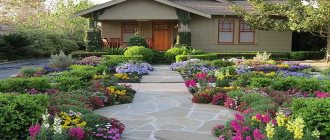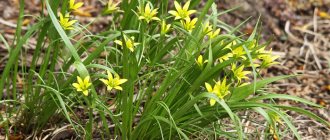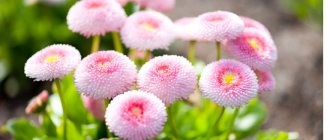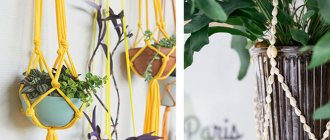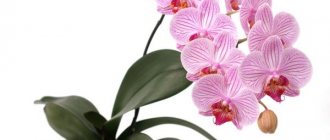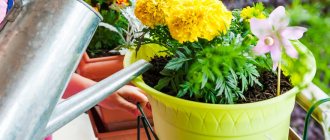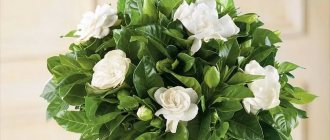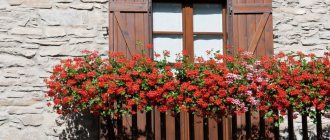Helenium is an annual or perennial plant of the Asteraceae family. This genus includes about 32 species. They can be found naturally in North and Central America, and most of them grow in the Western United States. It is believed that this plant was named helenium in honor of the wife of King Menelaus, the charming Helen, who became the cause of the war that broke out between Troy and Greece. It was described in the Iliad by Homer. What makes such plants stand out? The fact is that until a certain time they have a completely unremarkable appearance. At the end of the summer, when many plants are already blooming, helenium appears in all its glory. Its inflorescences-baskets of golden color, which can change their color, look very elegant and fill the garden with their “calm” beauty...
Description of plants of the genus Helenium
Helenium belongs to a genus of about 40 herbaceous perennials, annuals and biennials found primarily in North, Central and South America. It is an erect perennial wildflower that grows from 90 cm to 1.5 m in height and up to 1 meter in width. Some of the compact varieties reach a height of about 60 cm. This is an adaptable plant and will grow in any area that has sun or light shade, as well as in moist soils. In nature, the flower grows along the banks of streams and in wet meadows or other wetlands.
Flowering times vary depending on the species, but in general Helenium blooms from late summer to fall, when most other perennials are preparing for the winter season. Dense clusters of narrow, jagged, spear-shaped foliage are topped by a profusion of Daisy-like flower heads in golden yellow, bright orange and various shades of deep red. The flower petals are arranged in a single row of ray petals around a raised, domed central disc. Each petal has distinct jagged indentations along the edges.
Photo of Helenium flowers "Salsa"
Helenium, like Goldenrod, has an undeserved reputation for causing hay fever and allergies during flowering. But this is not true - the flowers of this plant have heavy, sticky pollen that is not easy to inhale and are pollinated by insects, not the wind. It blooms at the same time as Ambrosia, which is the real culprit.
Helenium attracts a wide variety of pollinators to the flower garden. It is especially valuable in late summer as a nectar plant for bees, butterflies and moths.
How to grow Helenium flower in the garden
These plants are quite easy to plant and care for. You just have to take into account a few nuances that we will describe.
How, when and where to plant Heleniums
The planting method described below applies to plants purchased in gardens src=»https://green-design.pro/wp-content/uploads/2021/03/sazhency-heleniuma.jpg» class=»aligncenter» width=»700″ height= "462″[/img]
- Choose a sunny location or light partial shade. Planting seedlings from pots is the most reliable method.
- Choose soil that will retain moisture. Helenium tolerates slight waterlogging better than most plants. Avoid dry sandy soils.
- The best time to plant Helenium is around the last week of March.
- The planting rate is 5 plants per square meter.
- Plants need to be established well before winter, so don't plant them after the end of June.
- Harden off the plants for a week or two before planting.
- Dig a hole twice as wide as the root ball. Add compost to the hole and mix it with the soil.
- Place the plant in the hole, mound the soil and compost around the root ball, and gently but firmly firm the soil. Water the soil around the root ball well. Add about 2 inches of mulch around the plant to retain moisture.
- For higher varieties, you need to install a stop using a peg and rope.
The soil
The Helenium flower loves acidic soil with a pH range of 5.5 to 7.0. The flower has widely spreading, shallow roots that are best suited to moisture-retaining soil. When planting in the ground, you need to add compost or other organic matter. This flower will benefit from moist or even poorly drained soil because the moisture helps keep its roots cool. An established plant can tolerate drier growing conditions, but the flower size may be smaller. It is best to use well-drained soil, but Helenium is clay tolerant. In soil that is too rich they grow too tall with large green leaves and few flowers.
You might be interested
Features of the perennial plant Arabis
Ageratum - blooming garden decoration
Anafalis - an original garden decoration
Light
Helenium grows well in full sun but will stretch out if it does not receive at least six hours of sun. If you don't have a sunny area, no problem. Helenium can grow in partial shade, but the flower color may not be as vibrant. In particular, the red color may not be as rich.
Temperature and humidity
Helenium tolerates humidity and hot summers well, but when planting, you should maintain a distance between flowers. This is important to prevent fungal diseases such as mold and rust in areas with high humidity.
Water
The Helenium flower loves moderate soil moisture, hence its nickname - swamp sunflower. Water early in the morning so all the leaves have time to dry.
For most perennials, one 3cm of rain or watering per week is recommended. It is worth carrying out additional watering in hot and dry weather. A layer of mulch is also helpful for cooling roots and retaining moisture in the soil.
Fertilizers
Heleniums do not require fertilizing, and on fertile soils one application of a balanced flower fertilizer in the spring is sufficient. Apply granular fertilizers away from the crown and foliage of the flower to avoid burns. Use low doses of slow-release fertilizer, as higher doses can cause root rot. Many gardeners add a little compost to the plant instead of fertilizer.
Mulching
Heleniums do better in cool soil than warm soil. They like their roots to be cool and their leaves to be exposed to the hot sun. How to create these conditions for them? A layer of mulch, especially shredded leaves or compost, will keep the roots cool during the summer heat. This will also provide adequate levels of nutrients as the mulch decomposes.
In frosty and windy weather in winter, Heleniums can sometimes “rise” from the soil, leaving voids around the roots. Spring mulch will fill any gaps around the flower's roots. Do not mulch near the plant stems, as this may cause rotting.
Transplanting and pruning Helenium
After a few seasons the bushes become denser. To rejuvenate flowers, dig up bushes and divide them every four years. In good conditions, Heleniums can spread quickly and their number in flower beds has to be limited.
Another way to help the plant not grow too tall is to pinch the ends of the stems in spring or early summer, when the flower grows to 15-20 cm in height. This promotes branching and better flowering.
In the fall, after flowering has finished, cut Heleniums to the ground to prevent the spread of insects and diseases.
Once the plant begins to bloom, faded heads are removed regularly to prolong flowering. If cutting each flower individually seems too labor-intensive, you can cut the top 15 to 20 cm off the plant instead.
Planting in open ground
What time to plant
It is necessary to plant seedlings in open ground only when night frosts are left behind. As a rule, this time falls in May or early June. For planting, it is best to choose a well-lit area, but you can also grow helenium in a shaded place. Light soil is best, but it must be rich in nutrients, well-drained and neutral. Before planting seedlings, it is recommended to dig up the soil with compost to the depth of a spade bayonet.
How to plant
It should be noted that the size of the planting hole should exceed the size of the root system by a couple of times. Before placing the plant in the hole, its roots must be kept in a container of clean water for several minutes. Seedlings must be planted at the same depth at which they were grown in containers. It must be remembered that between copies it is necessary to leave at least 30 centimeters, and the row spacing should be equal to 35 centimeters. When the flowers are planted, the surface of the soil should be sprinkled with a layer of mulch (humus or peat). A plant that is grown from seed through seedlings will begin to bloom only in the second year after planting. It should also be remembered that it is recommended to grow only species plants from seeds. Varietal species need to be propagated using vegetative methods; the fact is that flowers grown from seeds are not able to retain the varietal characteristics of the parent plant.
Reproduction of the Helenium flower
Over time, Helenium bushes will become denser and flowering will decrease. To maintain their viability, dig up the plant in the spring and divide the bush. Since each stem has its own root system, it is easy to divide it and plant it in new holes. If you divide the bushes every four years, your flowers will delight you with their beauty for a long time.
You can learn more about the propagation of Helenium from this video
Helenium can also be propagated by seeds. Start seedlings indoors in the spring, about 8-10 weeks before planting outdoors. Before adding to the soil, you need to soak them for a couple of hours in warm water, then for an hour in potassium permanganate and dry well. Cover them lightly with soil and keep them moist, remembering to ventilate, until they sprout. As soon as the seedlings produce 4 full leaves, they can be planted in the garden.
Remember! The characteristic features of cultivated varieties are not transmitted from the seeds of the “parent”. If this is a concern, buy fresh plants. On the other hand, if you like to experiment, seeds of different varieties can be very interesting. A plant grown from seeds will begin to bloom after 2 years.
Growing helenium from seeds
The seeds of such a plant have a low germination rate and it does not matter whether they are freshly harvested or not. Of course, if you have a strong desire, you can try to grow such flowers from seeds, but it is still easier to propagate them by leaf rosettes and dividing the bush.
Sowing seeds in autumn can be done directly into open ground. They can also be sown for seedlings in February or March, but it should be taken into account that such crops will require stratification. So, the seeds are distributed over the surface of the substrate, after which the container is placed in a polyethylene bag. After this, this container is put away on the refrigerator shelf for 4–6 weeks. After this, the container with the seeds is removed and placed in a warm place under artificial lighting. The optimal temperature for the emergence of seedlings is from 18 to 22 degrees. After the plants have 2 or 3 true leaves, they should be picked.
Diseases and pests of Helenium
Even though flowers are pest resistant, pests can cause harm to your plants.
- Aphid . These sucking insects can spread diseases by feeding on the undersides of leaves. They leave sticky marks on the foliage that attract ants. You can wash them off with strong water or use insecticidal soap.
- Slugs . These pests leave large holes in the foliage or eat the leaves completely. They leave a slimy trail, feed at night and tend to cause problems in wet weather. To get rid of slugs you need to collect them by hand, if possible at night. You can try to attract slugs to your traps using cornmeal or beer. For a beer trap, dig a hole in the ground and place a large cup or bowl in it; use something with steep sides so the slugs can't crawl back out once they crawl in. Fill the bowl about half full with beer and leave overnight. In the morning, the bowl should be filled with drowned slugs, which can be thrown away. For a cornmeal trap, place one to two tablespoons of cornmeal in a jar and place it on its side near the plants. Slugs are attracted to the smell, but they cannot digest the flour and it will kill them. You can also try placing a barrier around your plants using diatomaceous earth or even coffee grounds. They can't crawl on them.
- Spider mites . Tiny arachnid pests. They suck up plant juices, removing chlorophyll and introducing toxins that cause white spots on foliage. Because of them, the foliage turns yellow, becomes dry and covered in spots. Spider mites can be controlled with strong water pressure. Try insecticidal soap.
- Thrips are tiny insects that are black or faded in color. They suck plant juices and attack the petals, leaves and stems of flowers. The plant will have dotted, discolored speckling or silvering on the surface of the leaf. Many Thrips can be repelled by using aluminum foil between rows of plants. Remove weeds and debris from the garden bed after frost.
Flower diseases
- Powdery mildew . This is a fungal disease that occurs on the tops of leaves in humid weather conditions. The leaves have a whitish or grayish surface and may curl. Avoid powdery mildew by providing good air circulation to plants through proper spacing and pruning.
- Root rot . Pathogens cause root rot of seedlings as well as mature roots. Practice crop rotation and avoid planting related crops in the same area over several years. Dig up and discard infected plants. Make sure your soil has excellent drainage.
- Rust . A number of fungal diseases that cause rust-colored spots to appear on foliage and stems. Practice crop rotation. Remove infected plants.
- Mold can attack the plant if there is no air circulation. In this case, it is best to prune the plant back by half or two-thirds after it finishes flowering. This will help prevent further mold outbreaks.
How to use the Helenium flower in garden landscaping
Helenium is good for group or mass planting. It combines well with other perennials and herbs, including Asters, Boltonia, Liatris, late-blooming Salvias, Goldenrod, and tall Sedum species. The flower generally looks best when planted with other yellow perennial flowers, but blue or purple flowers will also complement.
Where is the best place to plant Helenium?
- In informal flower beds, combined with Echinacea, Asters and other flowers similar to Chamomile, it will attract a wide range of beneficial pollinating insects to the garden.
- Plant taller varieties in your garden where they look best in the middle or back of the border.
- Near artificial or natural ponds and wet areas of the garden.
- Wet soils in lowlands.
Tall Helenium plants can be planted near other tall flowers, which will keep the stems upright.
Popular varieties of perennial Helenium
Below is a small selection of popular ones from the more than 40 known Helenium species.
Helenium autumnale
This species is native to eastern North America. It usually blooms for 8 weeks or more from late summer until frost. Helenium autumnal and its numerous hybrids have the greatest color and diversity.
The natural form of this crop produces bright yellow flowers, while the hybrid varieties have various shades of yellow, orange, copper and red.
Helenium bigelovii
This species is native to western North America and can be found in the wild in Oregon, California and Arizona.
The plant has yellow flowers 5 cm wide and grows from 60 to 90 cm in height.
Helenium flexuosum
This is an eastern perennial American flower species native throughout the eastern and midwestern parts of the United States.
Grows up to 90 cm in height. The 4cm flowers captivate with yellow petals and prominent purple-brown centres.
Helenium hoopesii flower
In its homeland it is usually called mountain Helenium. This long-blooming species, up to 80 cm tall, produces large 8 cm yellow flowers with an orange center.
It is better to propagate by seeds.
There are also many hybrid varieties from short to tall that grow well in our area.
This video talks about the features of growing this American flower in our latitudes.
Features of Helenium
This perennial plant has a very interesting feature. In autumn, its root system dies off, as do the flower stalks. However, the annual shoot has underground buds, from which roots and a new rosette consisting of leaves grow in the fall. Young flower stalks will appear from this rosette next year. The familiar helenium bush is an independent plant growing close to each other. They have straight shoots that branch in the upper part, and they can reach a height of 150 centimeters. The alternately arranged leaf plates have a lanceolate shape. Inflorescences-baskets can be single or part of corymbose inflorescences. The baskets include marginal reed flowers, which can be brown, red, purple, orange or yellow, as well as central tubular flowers, colored brown or yellow. The fruit is a pubescent achene of an oblong-cylindrical shape.
Helenium - amber flower

